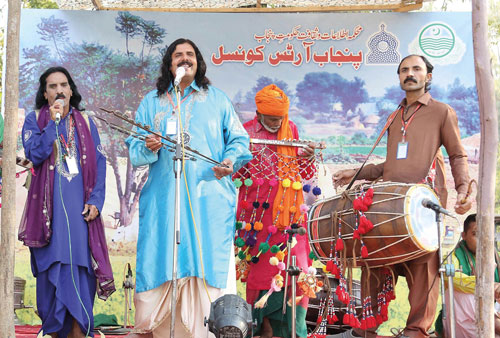Providing an ideal opportunity to experience the cultural diversity of the country, the ongoing folk festival of Pakistan, commonly known as ‘Lok Mela’, continues to attract a large number of people every day.
All provinces have exclusive collections for the visitors it sometimes become hard for them to give due time to each pavilion. Every pavilion is truly a window to the cultural diversity that exists within each area.
A detailed look at Punjab pavilion introduces the visitors with the wide range of colourful and dazzling crafts along with vibrant and energetic traditional folk music of the area. Punjab is the land of five rivers and its culture is very attractive and centuries old.
Keeping alive the spirit of fanfare and festivity, the Punjab pavilion depicting the indigenous folk culture, arts, crafts, traditional cuisine, folk music and folk entertainment remains the centre of attraction for the visitors.
As one enters the Punjab pavilion, it welcomes with more than fifty master craftsmen and craftswomen, who are seen sitting in the artistically erected stalls practicing centuries’ old traditional crafts including bone work, lacquer art (jundri ka kaam), Multani blue tiles, tie & dye, bock printing, wood carving, darree weaving, khaddar weaving, basketry, pottery, embroidery, zardozi, metal work, camel bone carving, shoe (khussa), needle work, etc.
Several female artisans are also taking part in the festival, giving a sense of gender equality, which is usually witnessed in almost every activity of Lok Virsa.
Among these craftswomen, the prominent is Hajra Bibi from Bahawalpur. She is a young lady and has ample knowledge of basket-weaving. She weaves many colourful items like baskets, changer, hand-fans, women’s footwear, chhaaj (grain separator), etc.
Surraya from Karror Pacca makes traditional ‘chunri’ (tie & dye work) with its tiny details and dark colours like maroon, green, yellow and red.
Male artisans are also proving their mettle by creating equally exquisite handicrafts. The outstanding among them is Ameer Buhsh, who is an expert in natural dyes. The ancient art of wooden block making has its centres in the lower Indus valley encompassing southern Punjab and all of Sindh. He has not only trained his family members but also imparted training to many artisans in other crafts of textile.
The other one whose work fascinates the visitors is Riaz Ahmed Mughal, an educated, young man and accomplished master artisan of wood lacquer work. He hails from Silanwali, District Sargodha which is known for wood based crafts. The art of lacquer work runs in his family. He has recently been conferred upon the President’s Pride of Performance Award by the Government of Pakistan.
A performance pit has been created in the centre of the Punjab pavilion. Folk singers and musicians entertain the visitors throughout the day with the loud beating of the ‘dholi’ (drums) in colourful costumes, which is the characteristic of Punjabi traditions. Folk artists like Basheer Lohar, Muhammad Aslam, Zafar Lohar, Shaukat Dholi is also entertaining the fans. The Punjab folk dance party is showcasing its performance on regular intervals. Regional traditional food stalls are also offering hot and mouth watering cuisines in the Punjab Pavilion. Traditional food of Punjab includes cornbread (makai ki roti), mustard greens (sarson ka saag), butter (makhan), Chatti ki lassi, and other popular dishes.
A live musical concert “Punjab Cultural Night” was held at the open air theatre within Lok Mela premises. Famous artists and musicians from Punjab enthralled the jam packed audience with their outstanding performance.



Comments are closed.